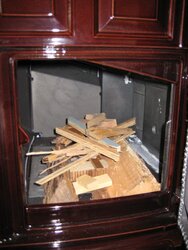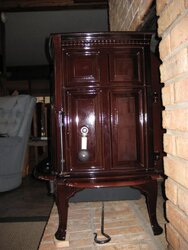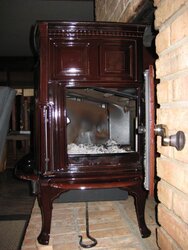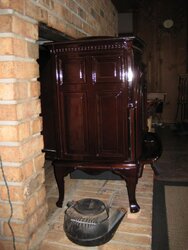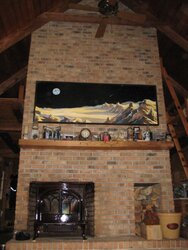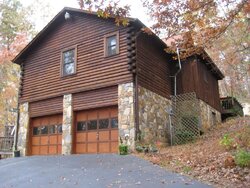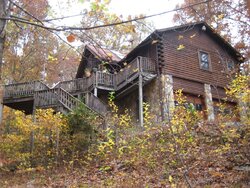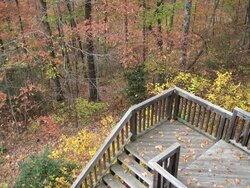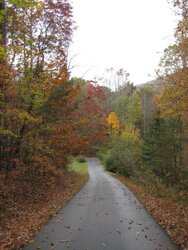On Tuesday we had a huge ice storm here in western NC and our electricity was off for ten hours. Too bad the new stove wasn't set up yet. I had to rely on our Woodstock Classsic on our lower level for heat. It does a fine job of heating the 1100 sq. ft. downstairs, but not much heat makes it upstairs to the remaining 1300 sq. ft. of living quarters. The upstairs was down to 58 degrees by 7 p.m.when we got our power back.
Yesterday, however, was a beautiful sunny day up in the 50s, so my friend Rich came back over to help me finish my installation. I had already managed to get the 20' ss liner up on my roof and down my chimney. I thought we would just have to move the stove to the hearth extension and make our connections, but of course I ran into a few complications. First, the T connector was two and half inches too long for the proper placement of the stove on my hearth. I had measured very carefully and already cut two inches off the pipe, but that calculation was done with the stove on a dolly on the other side of the room and trying to estimate where the connector would end up when it dropped down the flue. I wanted to err on the side of being too long, rather than too short and I guess I was too cautious.
Taking the T - connector off the liner and re-cutting it proved to be a very difficult job. We already had the stove on the hearth and didn't want to move it back off since it was so heavy, so I did the work through the five inch opening on either side of the stove. Here is a photo of how the stove sits on the extension.
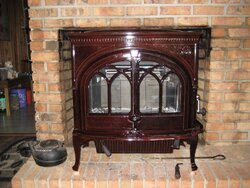
You might be able to imagine how difficult it was to get any leverage to even turn the screw driver to release the hose type clamp on the connector. It has to slip over a flange on the connector, so you have to back it off quite a few turns. Not only did I have to remove the connector to cut it, but I then had to put it back on to mark the holes I needed to drill to connect it the flue collar on the stove. That meant putting it back on to mark it, take it off again to do the drilling, and one more time putting it back on to make the final connection.
Finishing up the connection of the rain cap on the roof was pretty easy. I cut the liner with a hacksaw and that went smoothly. After I had top plate all sealed to the clay flue tile with silicone and the cap installed I looked down and saw the bats of insulation sitting on the ridge of my roof! I had been so focused on installing the cap I forgot to put in the insulation I had planned to wrap the liner with for the top three feet where the chimney exits the house.. So, I had to remove the cap parts and put in the insulation and then re-caulk the top plate and finish the installation of the cap.
Back inside the house I still had to seal up my chimney stop plate. When I fabricated my stop plate I cut an 8" square hole for the 6" liner so I'd have some wiggle room for positioning the liner to match with the final stove placement. To cover that 8" opening I had a 13" square top plate that I modified to close the hole down to a tight 6" fit around my ss liner. This was a job of work, as well. I initially installed it with the crown facing down, but when I went to make my T connection there wasn't enough space. I then had to take things apart and flip the top plate over so the crown faced up, which gave me an additional inch of space to work with. Fortunately, this was just enough.
Now, screwing that plate onto the stop plate in those tight quarters was nearly impossible. The top plate was much harder metal than I imagined and even with a brand new high speed steel drill bit I couldn't get enough leverage to go through the cap and sheet metal of the stop plate. I ended up having to build a brace that allowed me to use a board as a lever to put pressure on the back of the drill to make the holes. Very tedious in such tight quarters. Here is a photo of the finished product.
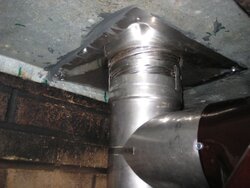
I used high temperature caulk for a good seal. It was tough reaching up there to spread it in place after it squeezed out. I also laid down a layer of insulation on top of the stop plate leaving about two inches of clearance from the liner.
Here are a couple more photos of the final installation:
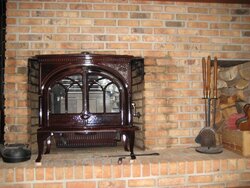
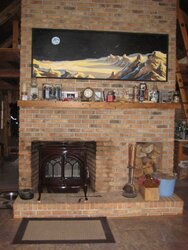
That discoloration of the brick around the fireplace opening is from some washing of the brick I did right before I took the photos. There was a mark from where the insert surround had been. Now that it has dried it looks like the rest of the bricks. Here is my first fire:
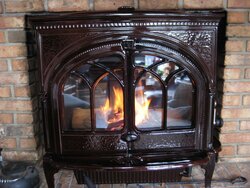
I've been cruising at 200 F for about an hour and now letting the stove cool down. I hope to get my 300 F burn done this evening and the final 400 F burn tomorrow morning, then it's fire away!
I'm really glad I decided to do the installation myself since I'm a rather exacting craftsman and I'm pretty sure I would have been upset with the quality of work the stove store would have done. I believe they do good work, but for the $685 they quoted me there wasn't going to be a stop plate or insulation around the top of the liner. The installation was a pretty demanding job on the physical level due to the tight quarters and the nearly 500 lbs. of the stove. Of course, cleaning 20 gallons of creosote out of my chimney and smoke chamber added to the unpleasantness of the job. In the end I'm pleased with how things turned out and am now looking forward to many years of enjoyment from my labors!
Yesterday, however, was a beautiful sunny day up in the 50s, so my friend Rich came back over to help me finish my installation. I had already managed to get the 20' ss liner up on my roof and down my chimney. I thought we would just have to move the stove to the hearth extension and make our connections, but of course I ran into a few complications. First, the T connector was two and half inches too long for the proper placement of the stove on my hearth. I had measured very carefully and already cut two inches off the pipe, but that calculation was done with the stove on a dolly on the other side of the room and trying to estimate where the connector would end up when it dropped down the flue. I wanted to err on the side of being too long, rather than too short and I guess I was too cautious.
Taking the T - connector off the liner and re-cutting it proved to be a very difficult job. We already had the stove on the hearth and didn't want to move it back off since it was so heavy, so I did the work through the five inch opening on either side of the stove. Here is a photo of how the stove sits on the extension.

You might be able to imagine how difficult it was to get any leverage to even turn the screw driver to release the hose type clamp on the connector. It has to slip over a flange on the connector, so you have to back it off quite a few turns. Not only did I have to remove the connector to cut it, but I then had to put it back on to mark the holes I needed to drill to connect it the flue collar on the stove. That meant putting it back on to mark it, take it off again to do the drilling, and one more time putting it back on to make the final connection.
Finishing up the connection of the rain cap on the roof was pretty easy. I cut the liner with a hacksaw and that went smoothly. After I had top plate all sealed to the clay flue tile with silicone and the cap installed I looked down and saw the bats of insulation sitting on the ridge of my roof! I had been so focused on installing the cap I forgot to put in the insulation I had planned to wrap the liner with for the top three feet where the chimney exits the house.. So, I had to remove the cap parts and put in the insulation and then re-caulk the top plate and finish the installation of the cap.
Back inside the house I still had to seal up my chimney stop plate. When I fabricated my stop plate I cut an 8" square hole for the 6" liner so I'd have some wiggle room for positioning the liner to match with the final stove placement. To cover that 8" opening I had a 13" square top plate that I modified to close the hole down to a tight 6" fit around my ss liner. This was a job of work, as well. I initially installed it with the crown facing down, but when I went to make my T connection there wasn't enough space. I then had to take things apart and flip the top plate over so the crown faced up, which gave me an additional inch of space to work with. Fortunately, this was just enough.
Now, screwing that plate onto the stop plate in those tight quarters was nearly impossible. The top plate was much harder metal than I imagined and even with a brand new high speed steel drill bit I couldn't get enough leverage to go through the cap and sheet metal of the stop plate. I ended up having to build a brace that allowed me to use a board as a lever to put pressure on the back of the drill to make the holes. Very tedious in such tight quarters. Here is a photo of the finished product.

I used high temperature caulk for a good seal. It was tough reaching up there to spread it in place after it squeezed out. I also laid down a layer of insulation on top of the stop plate leaving about two inches of clearance from the liner.
Here are a couple more photos of the final installation:


That discoloration of the brick around the fireplace opening is from some washing of the brick I did right before I took the photos. There was a mark from where the insert surround had been. Now that it has dried it looks like the rest of the bricks. Here is my first fire:

I've been cruising at 200 F for about an hour and now letting the stove cool down. I hope to get my 300 F burn done this evening and the final 400 F burn tomorrow morning, then it's fire away!
I'm really glad I decided to do the installation myself since I'm a rather exacting craftsman and I'm pretty sure I would have been upset with the quality of work the stove store would have done. I believe they do good work, but for the $685 they quoted me there wasn't going to be a stop plate or insulation around the top of the liner. The installation was a pretty demanding job on the physical level due to the tight quarters and the nearly 500 lbs. of the stove. Of course, cleaning 20 gallons of creosote out of my chimney and smoke chamber added to the unpleasantness of the job. In the end I'm pleased with how things turned out and am now looking forward to many years of enjoyment from my labors!


